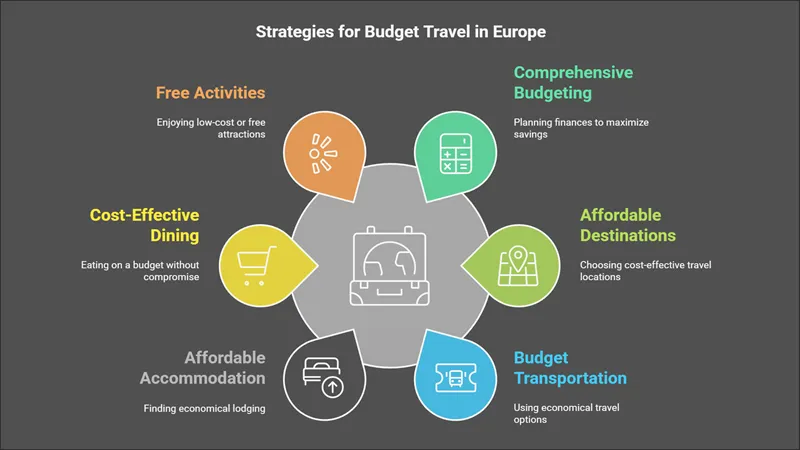Think traveling through Europe on a budget is impossible? Think again! Affordable European travel isn’t just a dream reserved for extreme couponers or minimalist backpackers. It’s absolutely achievable—and no, you won’t need to skip meals or sleep on train station benches to make it happen, even when exploring the cheapest European countries to visit.
In fact, with a bit of planning and the right destinations, you can experience Europe’s rich culture, stunning landscapes, and delicious cuisines for less than $50 a day. Yes, even in 2025! It’s all about embracing a budget travel philosophy—choosing affordable yet authentic experiences, and knowing where to save without sacrificing the magic of the journey.
Ready to discover the cheapest European countries to visit and explore the art of traveling meaningfully without breaking the bank? Let’s dive in!
Strategic Planning for Budget Travel

Comprehensive Budgeting
Planning your budget is the foundation of affordable travel. Start by accounting for all potential expenses—flights, accommodation, food, activities, visas, and insurance. For example, forgetting to budget for a Schengen visa fee could throw off your entire plan. Using a travel budget calculator or a budget template can help you visualize your expenses and avoid surprises.
Make use of budgeting tools like apps or spreadsheets to track your spending in real time. Apps like Trail Wallet or TravelSpend are great for breaking down costs and ensuring you stick to your plan.
Choosing the Right Destination
The key to budget travel? Picking destinations that offer incredible value. Countries like Portugal, Greece, and Hungary combine rich history, beautiful landscapes, and affordability, making them some of the cheapest European countries to visit.
Want to add variety? Consider a budget-friendly side trip to Morocco. With its vibrant culture and low costs, it’s an exotic addition that won’t break the bank.Focus on regions with a low cost of living—think Eastern Europe or the Mediterranean. Here, daily expenses like food and transportation are much more wallet-friendly, allowing you to stretch your budget without compromising on experiences.
Transportation Strategies

Affordable Air Travel
Getting to Europe on a budget is easier than you think. Low-cost airlines like Ryanair and EasyJet offer incredible deals, especially if you’re flexible with your dates and destinations. For example, snagging a mid-week flight to Budapest or Porto could save you hundreds!
To find the best prices, use flight search tools like Skyscanner or Google Flights. They allow you to explore the cheapest countries to fly to and set alerts for fare drops. Remember to pack light—budget carriers often charge extra for checked luggage.
Ground Transportation
Once you’ve arrived, Europe’s affordable transportation options make getting around simple. Trains are a scenic choice, but buses often cost less. Platforms like Omio and FlixBus help you compare prices and routes. For a social twist, consider rideshares with BlaBlaCar, where you can split costs with locals heading the same way.
For longer trips, evaluate Eurail passes against individual bus or train tickets. Passes can save you money if you’re hopping between multiple countries, while buses are ideal for shorter, frugal journeys.
Local Transit
Don’t underestimate the power of public transport! Local buses, trams, and subways are not only economical but also give you an authentic feel for the city. A day pass in cities like Prague or Lisbon often costs less than a coffee and ensures cost-effective travel to major attractions.
Pro tip: Download transit apps specific to each city to navigate like a pro and avoid unnecessary cab fares.
Accommodation Options

Booking in Advance
Finding affordable accommodations in Europe starts with planning ahead. Platforms like Booking.com and Hostelworld are great for comparing prices on hostels, guesthouses, and budget-friendly hotels. Early bookings often come with discounts, and many listings offer free cancellation, giving you flexibility without breaking the bank.
Alternative Lodging Solutions
Want to save even more? Consider volunteer stays with platforms like Workaway or WWOOF, where you exchange work for free room and board. For a more personal touch, try Couchsurfing or pet sitting with services like TrustedHousesitters, where you stay with locals for free and get an authentic cultural experience.
Budget Accommodations
Hostels and dorm rooms remain top choices for budget-conscious travelers. Many hostels offer perks like free breakfasts, social activities, and shared kitchens to help you cut costs further. Smaller guesthouses can also provide a cozy and affordable alternative, especially in less touristy areas.
Self-Catering Lodgings
When planning for self-catering travel in Europe, prioritize accommodations with kitchens. Preparing your own meals not only saves money but also lets you experiment with local ingredients. Imagine cooking fresh pasta in Italy or trying out authentic Hungarian recipes in Budapest—budget-friendly and memorable!
Food and Dining on a Budget – Cheapest European Countries to Visit

Cooking Your Own Meals
One of the best ways to save money on food while traveling is to cook your own meals. Shop at local markets and grocery stores for fresh, affordable ingredients—you’ll get a taste of local life while sticking to your budget. Imagine picking up a baguette, cheese, and fruit in France for a perfect picnic lunch at a fraction of the cost of dining out.
Finding Discounted Food
For even more savings, try food apps like Too Good To Go, which lets you buy restaurant leftovers at steep discounts. It’s a win-win for your wallet and reducing food waste!
Budget Eating Out – Cheapest European Countries to Visit
Dining out doesn’t have to break the bank. Opt for local eateries and street food—they’re often cheaper and more authentic than touristy restaurants. In Budapest, for example, you can enjoy a hearty bowl of goulash from a street vendor for just a few euros.
Limiting Alcohol Consumption
Let’s face it: alcohol can eat up your travel budget fast. By reducing alcohol intake, you’ll not only save money but also free up funds for more meaningful experiences. When you do indulge, consider local wines or beers, which are often cheaper and add to the cultural experience.
Cost-Effective Activities and Experiences – Cheapest European Countries to Visit

Free and Low-Cost Attractions
Europe offers countless free activities in its cities, from world-famous parks to iconic landmarks. Explore historical gems like Rome’s Piazza Navona or Paris’s Sacré-Cœur Basilica—both completely free. Many cities also boast free museum days or open-air cultural events. For nature lovers, Europe’s stunning landscapes, like Croatia’s coastline or Switzerland’s hiking trails, provide unforgettable experiences at no cost.
Free Walking Tours and Self-Guided Exploration
Make the most of complimentary city tours offered in major destinations. Companies like Sandemans provide engaging, tip-based walking tours that let you learn about the city while staying on budget. Prefer to explore at your own pace? Download Rick Steves’ Audio Europe or similar tools for insightful, self-guided adventures.
Independent Exploration – Cheapest European Countries to Visit
Skip pricey organized tours and embrace independent exploration. Rent a bike in Amsterdam, wander through Prague’s cobblestone streets, or hop on public transport to reach hidden gems. This approach not only saves money but also lets you craft a flexible itinerary tailored to your interests. Why pay for a tour guide when you can create your own unique adventure?
Travel Timing and Duration
Traveling During Shoulder and Low Seasons
Timing is everything when it comes to cost-effective travel in Europe. Consider visiting during the shoulder season (spring and autumn) or even the off-season (winter). Not only will you enjoy lower prices on flights, accommodations, and attractions, but you’ll also avoid the crowds, allowing for a more authentic experience. Imagine wandering through Rome’s streets without the summer hordes—sounds dreamy, right?
Long-Term Travel
If you can, embrace long-term travel. Staying in one location for longer periods can significantly lower your daily expenses. Monthly rentals, discounts on extended stays, and the chance to cook at “home” can make this lifestyle surprisingly affordable. Plus, longer stays give you time to immerse yourself in local culture, creating a deeper and more meaningful travel experience.
Balancing Budget with Enjoyment
Personal Travel Philosophy
Budget travel isn’t just about saving money—it’s about experiencing more. Prioritize cultural immersion by exploring local markets, attending community events, or simply enjoying a leisurely coffee at a neighborhood café. These small moments often provide the richest memories and don’t require a hefty price tag.
Treating Yourself
While saving is key, don’t forget to splurge occasionally. Allocate part of your budget for a special activity—like a gondola ride in Venice or a fine-dining experience in Paris. These occasional treats can elevate your trip and remind you that traveling isn’t just about being frugal; it’s about enjoying life’s adventures to the fullest.
Evaluating the Quality of Budget Travel
Avoiding Extreme Measures
Budget travel doesn’t mean you have to sacrifice comfort or legality. Steer clear of strategies that compromise your enjoyment, like skipping meals or overcrowding hostel rooms. For example, instead of relying on free-but-questionable accommodation, use reputable options like Couchsurfing for safe, cost-free stays. Ensuring that your actions respect local laws and customs not only keeps you safe but also supports responsible travel.
Balancing Cost and Experience
Sustainable budgeting is all about balance. Focus on frugal travel strategies that prioritize meaningful experiences over rigid penny-pinching. For instance, skip a pricey tour and explore independently, but don’t hesitate to spend on a once-in-a-lifetime experience, like visiting the Alhambra in Spain. Travel is about enriching moments, and smart planning lets you enjoy them without overspending.
Sample Itinerary – Cheapest European Countries to Visit
Example Route
Here’s a 2-week itinerary combining affordable destinations and cultural highlights:
- Budapest, Hungary (3 days): Explore thermal baths, the Chain Bridge, and free walking tours.
- Krakow, Poland (3 days): Visit the historic Old Town and enjoy budget-friendly Polish cuisine.
- Prague, Czech Republic (3 days): Discover Charles Bridge and vibrant local pubs.
- Lisbon, Portugal (3 days): Wander through Alfama and savor pastel de nata.
- Side Trip to Morocco (3 days): Fly to Marrakech for vibrant souks and stunning architecture.
Conclusion

Traveling through the cheapest European countries on a $50 daily budget isn’t just a possibility—it’s an exciting way to unlock incredible adventures without breaking the bank. Smart budgeting transforms your travel experience, letting you dive deeper into Europe’s cultural gems, savor authentic local dishes, and extend your journey, all while keeping financial stress at bay.
Ready to master your travel finances? Check out our Ultimate Guide to Wallet-Friendly Trips, where you’ll find a handy trip budget calculator to plan your expenses effortlessly. This comprehensive guide is packed with expert strategies and insider tips to make every trip affordable and unforgettable. So why wait? Start planning your next budget-friendly European adventure today and discover just how far your travel dreams can take you!



